AFRICA
Operation Moheli, Comoros (2006)
One particularly effective activity has been the Junior Ecoguard programme, a youth group that the BP team has initiated in Nioumachoua. The Junior Ecoguards have performed sketches, organized beach clean-ups and have received training in turtle and seagrass survey techniques.
Conservation Comoros (2005)
The final report for the Conservation Comores 2005 team is indeed full of many accomplishments. The team performed over 300 butterfly transect walks and over 200 bird point counts on Grande Comore and Anjouan. This resulted in updated information on the patterns of endemic richness and the status of rare species.
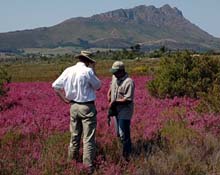
Tulbagh Renosterveld Project, South Africa (2005)
The Department of Agricultures Landcare project has been involved in mapping the sensitive areas in the valley and identifying priority areas for conservation. The Landcare coordinator for the area has approached our team to develop similar identification guides that we had for our project. These identification guides will be used to inform landowners of the special plants occurring on their farm.
Bat Conservation, Madagascar (2004)
We conducted a survey of bat roosts in the Zahamena-Ankeniheny corridor to identify key sites for conservation. Preliminary results from the western flank of the corridor indicate that most of the Madagascar flying fox Pteropus rufus roosts are located outside of the main block of intact forest.
Mpingo Conservation Project, Tanzania (2004)
This quarter the MCP has made an important step forward by gaining approval from Kilwa District Council for the first Village Forest Management Plan in the area. The plans were approved for Kikole village, one of our four pilot areas, and also for three other villages around Kitope Forest Reserve.
Studying the Impacts of Plant Exploitation on Habitat and Gorilla Populations, DRC (2001)
In November 2006, forest monitoring was conducted on Mount Kitale within the Itombwe Forest to assess plant exploitation by local populations. Two pitsaws were found from which 180 planks were produced and sent to Bukavu Town. This is a demonstration that the forest is still under severe threat due to illegal timber production.
Survey of Elephant Movement and Corridor Issues in Western Ghana and Eastern Cote D Ivoire (2003)
Forest elephants of West Africa have suffered a drastic decline in numbers, presenting a possible threat to their long-term survival. In order to address this threat, a team set out in 2003 to develop a regional and country-specific elephant conservation strategy. Based on their research, the establishment of a cross-border corridor has been proposed as a measure to increase elephant populations and improve their habitats.
Read more about projects in Africa...
ASIA / PACIFIC
Gangetic Dolphin Research and Conservation, India (2006)
The Dolphin Conservation Team has been busy over the past two months with advocacy work to save the Gangetic dolphin in the Brahmaputra river system. Oil India Ltd, a premier petroleum company of India, is planning to conduct seismic surveys in a 4500 sq km area of Eastern Assam, which consists mainly of river bed and islands of the Brahmaputra River. Such surveys are generally the first stage in oil exploration to measure discontinuities in the underlying rock strata, such as oil and gas pockets.
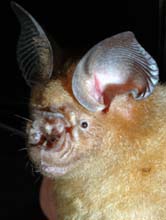 Bat Conservation at Cat Ba Biosphere Reserve, Northeast Vietnam (2006)
Bat Conservation at Cat Ba Biosphere Reserve, Northeast Vietnam (2006)
Twenty-two bat species are known to occur in the study area, including the globally endangered lesser leaf-nosed bat (Hipposideros turpis), which is common in Cat Ba but very rare elsewhere in the world. Results obtained from the current survey include a number of individuals with strange characteristics, including the pipistrelle bat (Pipistrellus sp.) and the horseshoe bat (genus Rhinolophus).
Philippine Forest Turtle (2006)
Surveys for the critically endangered Philippines forest turtle (Heosemys leytensis) have already started in two municipalities of southern Palawan, Philippines. Locals living near rivers, creeks, lakes and ponds are being interviewed, and in order to increase conservation awareness, education materials have been created and will be distributed in early January.
Community Based Biodiversity Conservation in Southern Cebu Philippines (2006)
The island of Cebu is considered both an endemic bird area (EBA) and an important bird area (IBA) due to the presence of six restricted range species and two endemic bird species the Cebu Flowerpecker (Dicaeum quadricolor) and the Black Shama (Copsychus cebuensis). The project, which began in February and concluded in August, focused on generating ecological information and breeding behaviour of the Black Shama.
Conservation Status of the Montaine Slender Loris, Horton Plains National Park, Sri Lanka (2006)
A baseline survey was initiated in 2002 and continues to date. The current study to determine the conservation status of Montaine Slender Loris began in June 2006 and is ongoing, and thus far, it is yielding some important observations.
CROC Project, Philippines (2005): Thinking of Victorino
Victorino Montañedo lives in a small village called Dunoy. Fifteen years ago he built a small wooden house in the forest and cleared the land to cultivate rice and corn. He owns a chainsaw and with the money earned from logging he sends his children to school in the nearby village. Not far from his house there is a small lake. Victorino knew there were crocodiles in the lake but didnt care much about it: his wife doesnt like the taste anyway. He had a plan to convert the lake into a rice field but that could wait until next year.
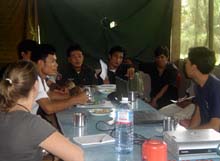 Extending Chelonian Research, Education and Conservation, Cambodia (2005)
Extending Chelonian Research, Education and Conservation, Cambodia (2005)
The Cambodian Turtle Conservation Program (CTCP) held a training course in October on turtle and tortoise conservation for the CI rangers. Participants learned about turtle ecology and identification and the Asian turtle trade through slides, photos and shells that had been collected from local people. One of the main goals of the course was to explain how to take care of confiscated turtles and tortoises before reintroduction back into the wild.
Calayan Rail: Conservation of an Island Endemic, Philippines (2005)
The Calayan Rail Project was conducted by Isla Biodiversity Conservation Inc. (ISLA), an environmental organization established by members of the pioneering expedition to the Babuyan Islands in 2004 that discovered the Calayan Rail (Gallirallus calayanensis. The general goal of the project was to initiate a long-term program for the conservation of the Calayan Rail and other wildlife and natural habitats of Calayan Island.
Frogs of Gede-Pangrango, West Java, Indonesia (2006)
We have presented our frog conservation program to six schools around the vicinity of Gede Pangrango National Park and teacher training. Starting this month we also started monitoring work, which will be finished in March 2007. In addition to this, we will also take frog skin samples using dry swabs (no killing or harming the frogs) to check for chytridiomycosis (a skin disease that might be responsible for amphibian population declines in Australia, South America and other locations globally).
Taking Bat Conservation Education and Awareness to the Streets: Bat Count Philippines (2006)
Bat Count Philippines has always been fortunate to have the cooperation of local government units in extending environmental education to the public. This past month we brought our bat awareness and education campaign to the streets with street dancing at the Province of Oriental Negros Annual Festival.
Giant Frugivorous Monitor Lizards in the Philippines (2005)
Work on Polillo Island has concentrated on identifying key resources for lizards in degraded forests, comparing population structure in habitats of different quality and examining the animals role in the dispersal of Pandanus and Canarium seeds.
Assessment of Traffic Disturbance to Tibetan Antelope in Hoh-Xil National Nature Reserve, China (2005)
The Tibetan antelope (Pantholops hodgsonii), otherwise known as chiru, is one of the worlds most endangered species (IUCN Red List EN) and has been listed on Appendix I of the Convention on International Trade in Endangered Species of Wild Fauna and Flora (CITES) since 1979. Current threats to this species include degradation of the habitat and human disturbance.
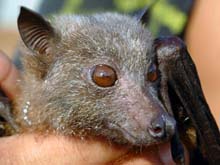 Action Tayam Peh, Nicobar Islands, India (2004)
Action Tayam Peh, Nicobar Islands, India (2004)
The team has completed their field work and is analyzing data. Information continues to trickle in from the field, and team member Ivan reported that while collecting bamboo from a site near his village in the middle Andaman Island, he encountered bamboo bats in a hollow. In his own words, which came as an SMS, Maam the slit in the bamboo is so small it is amazing how the bat might have got in
it is amazing.
Nepenthes, Indonesia (2002)
A nepenthes guide book (English version) has been printed and will be distributed publicly through the Sumatra region of Indonesia. The team also plans to distribute the book to the IUCN Species Survival Commission for the Carnivorous Pitcher Plant as a way to garner more support and urge them to take action to conserve this species.
KATALA QUEST, North Palawan, Philippines (2003)
Katala Quests main objective is to assess the status of the critically endangered Philippine cockatoo (Cacatua haematuropygia) and associated vertebrate communities in lowland forests of northern Palawan. The team discovered four active cockatoo nests on Dumaran Island where they banded six hatchlings, all in good condition.
Effect of habitat size on reproductive success of Myristicaceae (Gymnacranthera farquhariana): An endangered tree species of Western Ghats, India (2003)
Distribution maps developed by the project team based on vegetation analyses revealed that the Myristica swamps have a distinct plant community and behave as island ecosystems in the lowland evergreen forest of Western Ghats, India.
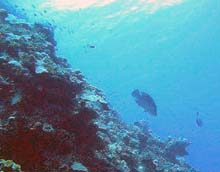 Finding Napo, Marshall Islands (2004)
Finding Napo, Marshall Islands (2004)
After the madness of preparing for fieldwork, including loading boxes of sampling gear, dive equipment and food onto a barge in Majuro (capital of the Marshall Islands), the team is on their way to Rongerik Atoll, where they will be stationed for the next three weeks collecting distributional and abundance data for rare fishes and corals.
Project Garuda, Indonesia (2002)
The Project Garuda team recently established a Raptor Center at Panaruban highland as an innovative approach to wildlife conservation, especially relating to confiscated wildlife by the Forestry Department due to illegal capture and trade. We hope the Panaruban Raptor Center will be a great approach to saving raptors and their habitat.
Read more about projects in Asia and the Pacific...
EURASIA
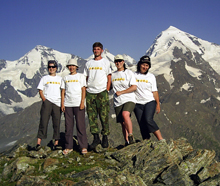 Supporting Conservation of the West Caucasian Tur (Capra caucasica), Georgia (2006)
Supporting Conservation of the West Caucasian Tur (Capra caucasica), Georgia (2006)
A survey was conducted by the team during their first expedition in June and revealed that hunting of the West Caucasian Tur in Svaneti is quite high in spite of the fact that the Red List of Georgia forbids hunting and poaching remains as the greatest threat to this species. According to a questionnaire conducted by the team, 15 local hunters identified eight key areas where they go to hunt Tur.
Conservation of Globally Threatened Bird Species, Azerbaijan (2004)
We are currently developing a Caretaker's network at a national level and have selected 15 IBAs where we will implement the project. We are working on skill development of our caretakers through trainings and face-to-face meetings and teaching them about the importance of biodiversity conservation. In order to make this possible, we are seeking small grants for the local caretakers. Winter migration monitoring has started in the IBAs and we will continue with mid-winter counts.
Development of Conservation Measures for Darevskys Viper in the Caucasus (2005)
This project was aimed at the development of conservation measures for the Darevskys viper (Vipera darevskii) with the aid of intensive field work, which included range clarification, snake marking, census, tracking, studies of distribution across elevations and habitats, daily and seasonal activity patterns, reproduction and other ecological issues.
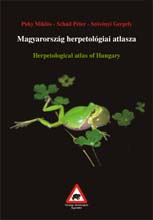
Monitor Project, Hungary (2002)
After much work, the Toad Action Group Association has finally published the Herpetological atlas of Hungary. While the compilation of the atlas took quite some time, the team hopes their efforts will result in an extraordinary outcome. The book introduces the results of intensive herpetofauna mapping.
Read more about projects in Eurasia...
LATIN AMERICA / CARIBBEAN
Green Corridor Project (2006)
In 2005 Conservación Argentina, in collaboration with the Fundación Vida Silvestre Argentina (FVSA, WWF partner) and the Ministry of Ecology of Misiones Province (MEM), designed a strategy to create a new protected area between Urugua-í and Foerster provincial parks. During 2006 we acquired 76 hectares in the corridor with the support of IUCN-Netherlands and FVSA.
An Ecological Study of the Bloody Bay Poison Frog, Trinidad & Tobago (2006)
The project has progressed well and after three months in the field, the team is currently in the analysis and write-up phase. Conservation education and awareness efforts continue with small workshops at schools on the main island of Trinidad, not only on the study species, Mannophryne olmonae, but on biodiversity as a whole.
Assessment of Seabird Bycatch in Peruvian Artisanal Fisheries, Peru (2005)
A paper based in part on the studies conducted during the BPCP project of 2005 on the Waved Albatross (Phoebastria irrorata) has finally been published. Based on results from that paper, Birdlife International has started a discussion forum on the waved albatross to determine whether or not it is necessary to upgrade the species to Critically Endangered. View the topic and follow the link to Threatened Seabirds.
Crax Alberti Colombia (2005)
Fundacion ProAves is delighted to report that BPCP-supported conservation efforts over the past two years are indeed working to protect the Blue-billed Curassow, a Critically Endangered species that is now only found in Colombias Magdalena Valley.
Community Participation for Long-term Conservation of the Andean Cat, Argentina (2003)
The Soul of the Andes is a long-term strategy that couples scientific research and community participation for the conservation of the endangered Andean cat in Argentina. It also aims to use this mysterious felid as a focal species for the conservation of the High Andes ecosystems.
Incidental Capture of Seabirds, Argentina (2003)
Based on the high enthusiasm and support from local communities, we aim to create a strong and coordinated network of volunteers who can gather data on the status and trends of seabirds. Volunteers of this network received training on data collection for long-term monitoring of beached seabirds and made surveys of a particular stretch of beach.
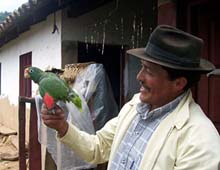 Alder Amazon Project, Argentina (2003)
Alder Amazon Project, Argentina (2003)
With the support of Loro Parque Fundación and the cooperation of Asociación Armonía, the Alder Amazon Project has become an international programme. We are conducting surveys in Bolivia to determine Alder Amazon status.
Diversity Patterns of Amphibians in Lowland Amazonian Forests, Southeastern Peru (RFP, 2006)
A photographic guide to the Reptiles of Los Amigos, Manu and Tambopata is southern Peru has been completed. This guide consists of eight laminate plates with images from about 80 species of reptiles that occur in the region.
Action to Stop Titicaca Flightless Grebe Accidental Fishing Deaths, Bolivia (2006)
The team began monitoring activities this month to gather data on grebe mortality due to fishing nets. To do this, we have been working with three communities and are planning to develop this work with eight more.
Read more about projects in Latin America and the Caribbean...
MIDDLE EAST
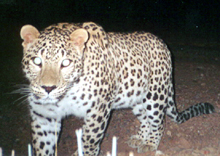
Iranian Cheetah (2006)
In November, a large Persian leopard (Panthera pardus soxicolor) was captured by camera traps in Sarigol National Park. This is the first picture of the leopard in northeastern Iran which was caught through a survey on the status and ecology of the Persian leopard.
Future of the Syrian Serin in Lebanon (2005)
In 2005, the team identified two foraging sites for the Syrian Serin in the Al- Shouf Cedars Nature Reserve in Lebanon, where the bird was monitored and ringed during its post-breeding stage. Simultaneously, a national project conducted by SPNL, the local BirdLife partner, was conducted to update national Important Bird Areas (IBAs). The two projects were collaborating to identify the distribution of the bird on a national basis.
Read more about projects in the Middle East...

